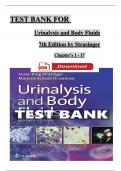Exam (elaborations)
TEST BANK For Urinalysis and Body Fluids, 7th Edition by Strasinger, All Chapters 1 - 17, Complete Newest Version (100% Verified)
- Course
- Institution
- Book
TEST BANK For Urinalysis and Body Fluids, 7th Edition Chapters Urinalysis and Body Fluids, 7th Edition by Strasinger pdf Urinalysis and Body Fluids, 7th Edition Chapters 1 - 17 pdf Urinalysis and Body Fluids, 7th Edition pdf TEST BANK For Urinalysis and Body Fluids, 7th Edition Chapters 1 - 17 ...
[Show more]



